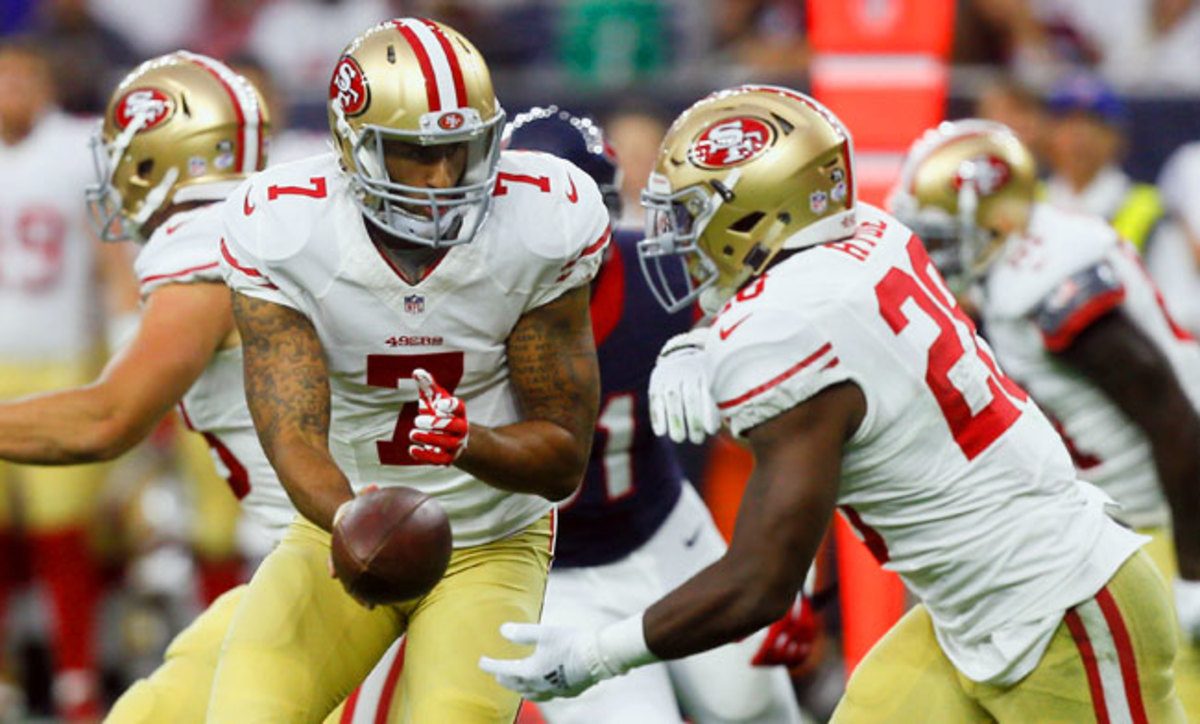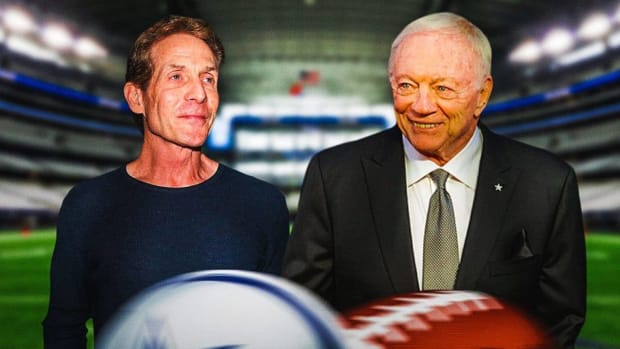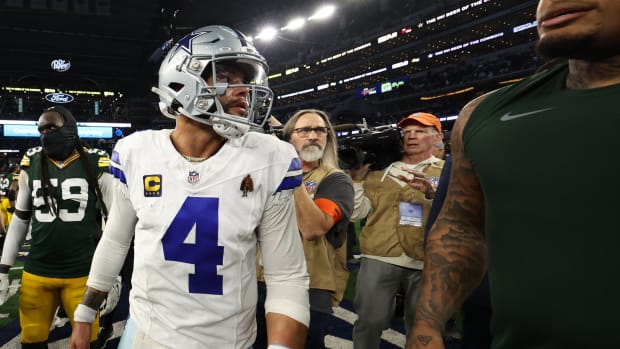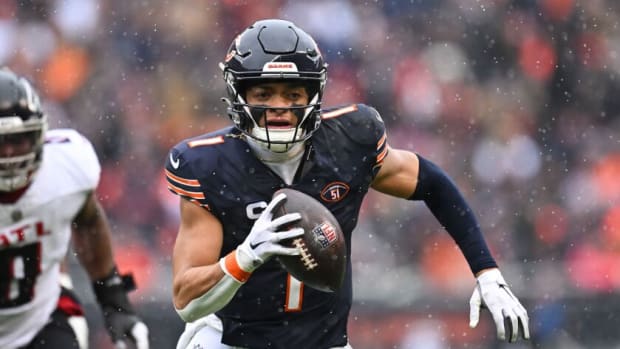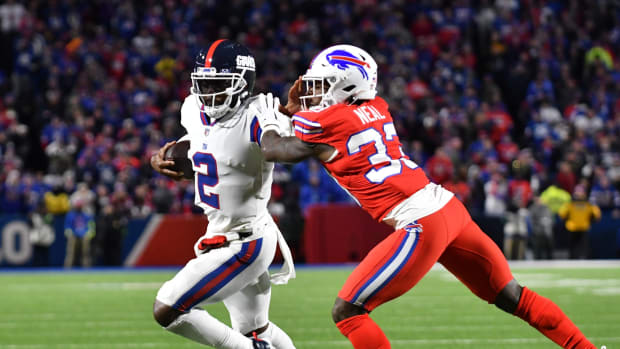Fixing Colin Kaepernick
You may have heard that the 49ers are enduring some recent changes. Gone: head coach Jim Harbaugh and most of his staff; seven-time Pro Bowl linebacker Patrick Willis and his expected long-term replacement, Chris Borland; five-time Pro Bowl defensive lineman Justin Smith; stud outside linebacker Aldon Smith; starting defensive end Ray McDonald; overachieving corner Perrish Cox; starting cornerback Chris Culliver; and sturdy linebacker Dan Skuta.
That’s just the defense.
Gone on offense: eight-time 1,000-yard rusher Frank Gore; starting wide receiver Michael Crabtree; leading backup wideouts Stevie Johnson and Brandon Lloyd; three-time Pro Bowl guard Mike Iupati; and starting right tackle Anthony Davis.
It seems the 49ers have been reduced to something more like the 25ers—about half of what they were. Many would characterize this as a franchise overhaul. But it’s not a complete overhaul, because of the quarterback.
No team caters more specifically to its quarterback than the 49ers do with Colin Kaepernick. He’s a distinct specimen. Some have suggested that a second straight poor season from the 27-year-old could mean he’ll join the mass exodus. Just 18 months ago, discussing a possible Kaepernick departure would have seemed unfathomable. He was the quarterback who led San Francisco to two straight NFC Championship Game appearances. His strengths were dynamic: rocket arm, long-striding speed and…well, pretty much those two things, which usually were enough. But the trained football eye could see the flaws that defenses, with more film study, have learned to exploit. Kaepernick’s mechanics are gangly and erratic. His arm is strong, but only strong. If he were a pitcher, he’d have a fastball and nothing else; if he were a golfer, he’d have just a driver in his bag; if he were a basketball player, he’d dunk over anyone but never hit a jump shot. You get the point.
There are fundamental flaws to Kaepernick’s quarterbacking. His footwork is erratic. That stems from unsettledness in the pocket. If his first read is not immediately defined as open, Kaepernick is likely to abandon the play design, even if he’s yet to fully complete his drop-back. He’s an explosive mover, but also a stiff one. Defenses don’t necessarily mind him breaking down and going out of structure the way they mind Russell Wilson doing this. Wilson can hurt you in a variety of ways on the move. Kaepernick is a limited passer while on the move and prone to mistakes; he’s not nearly as effective outside the pocket as his raw physical abilities might suggest.
Kaepernick has only made 45 starts (six of them in the playoffs). Typically, that’s not quite enough to judge an NFL quarterback. (Many say the number is 50 regular-season starts.) But he’s been so cemented in his style and has made such little progress toward correcting his issues that rendering judgment feels safe.
So Kaepernick is what he is. The question the Niners will face in 2016 and beyond is: Can we work with and around Kaepernick long-term? The answer will depend largely on the answer to 2015’s question, which is: How do we play with and around him?
It’s imperative they simplify the system. For the most part, Harbaugh and previous offensive coordinator Greg Roman did a great job with this, putting Kaepernick in a power run-based offense. (Though the Niners last year became less consistent on the ground and the coaches at times drifted away from that M.O.) New coordinator Geep Chryst is expected to run a very rudimentary scheme, which is a plus. Chryst must concoct plays that clearly define Kaepernick’s initial read. When given the comforting clarity, Kaepernick’s raw talent shines. Otherwise his play becomes randomized.
We talk all the time about defining reads for these young, raw, mobile quarterbacks. What does that mean? In Kaepernick’s case, a defined read needs to be a play that presents an immediate either/or decision. Unrefined at going through multiple progressions, Kaepernick is going to treat every play like an either/or decision anyway (either he throws to the first option, or he breaks down and moves in hopes of figuring something else out along the way). One concept that’s conducive to this is play-action. The QB fakes the handoff and then, depending on the type of fake, he has either a safety or linebacker to read upon turning around to face the defense again. If the safety or linebacker has fallen for the fake, throw downfield. If not, check it down. Or run, depending on the design.
Another way to create a defined read is to use three-step timing on passes; the nature of the routes and blocking compels the quarterback to get rid of the ball in less than two seconds. Kaepernick, however, isn’t the sharpest pre-snap reader, doesn’t always unleash the ball on time here.
Screen passes are another option. There, the timing is a little less stringent and the play design almost always presents only one possible option.
The Niners have done these things over the years. However, GM Trent Baalke didn’t necessarily provide the type of weapons most conducive to this approach. Wideouts Anquan Boldin, Michael Crabtree, Stevie Johnson and Brandon Lloyd, for example, were quality players, but all pretty much the same: intermediate possession targets. This year, Boldin is back—and he’s still capable of making contested catches, which is why he’ll remain Kaepernick’s go-to guy in critical situations—but Torrey Smith is now lining up on the other side. The ex-Raven is a straight-line speedster who provides a vertical element to this offense. His presence will stress defenses and impact how the safeties are used. This makes coverages clearer, serving to help define a read.
The signing of Reggie Bush is also part of the equation. He won’t be the featured back—second-year pro Carlos Hyde is ready for those duties—but he will get meaningful snaps as a movable chess piece. Defenses will have to take special account for Bush. How they go about this will often tip the coverage—yet another way of creating defined looks for the quarterback. And Bush, though not as explosive at 30 as he was a few years ago, is still viable on screens and short area options routes. More read-defining tactics.
Along these same lines, you can also expect increased snaps for last year’s fourth-round pick Bruce Ellington, a lightning strike of a wideout who can be deployed on gadget plays. Gadgets equal defined reads.
If the passing game doesn’t take this simpler, more concise shape, the Niners will struggle to sustain drives. Hyde, who has good balance for a 230-pounder, might be ready for a feature role, but with two new starters along the O-line (left guard Brandon Thomas and, tentatively, right tackle Erik Pears), he won’t be running behind the same quality of man-blocking that Gore ran behind. That’s why it’s important for Chryst to also incorporate more designed runs for Kaepernick. (Too many of Kaepernick’s 639 rushing yards last season came off scrambles.) Needless to say, designed runs are about as defined as reads get.
49ers Nickel Package
1. A lot of people, both in and out of football, have asked what in the world happened to Vernon Davis last season. A 59-catch, 814-yard per season guy since 2009, the two-time Pro Bowler registered only 26 receptions and 245 yards in a drop-infested 2014 campaign. Injuries were a factor at times for the now-31-year-old, but purportedly not enough to explain the extremity of his drop-off. The best educated guesses have been that Davis’s 2014 offseason holdout was a hindrance to him. Though talented and charismatic, Davis needs reps in order to thrive. With no leverage whatsoever to ask for a new contract now (he’s in the final year of his deal), Davis has been around San Fran’s facilities this past offseason. Maybe that’s all it will take for him to bounce back.
2. The O-line might be downgraded, but it at least still has the one thing every team covets: a left tackle who moves well in the ground game and can be trusted one-on-one in pass protection. Fundamentally, Joe Staley is as good as anyone in the league.
3. What will the defense look like under new coordinator Eric Mangini? Probably a lot like it did under predecessor Vic Fangio—at least on first and second downs. Both men run a fairly straightforward 3-4. In sub-packages, Mangini may use more hybrid looks and disguises. But where he once had two prime figures to build around—Aldon Smith, and last year’s fifth-round pick, Aaron Lynch—he now has just one. And it’s the less proven of the two. Lynch has long arms and good hands. Stylistically, he can replace Smith opposite Ahmad Brooks. Though quiet production-wise last season, the versatile 31-year-old Brooks has always been superb at doing the little things that can swing a play.
4. It’s hard to envision this linebacking corps not taking a step back in 2015. Borland’s unexpected retirement leaves the Niners with Michael Wilhoite starting alongside NaVorro Bowman inside. Wilhoite was very good as a fill-in last season, but playing every down next to a man who’s been out of football more than a year recovering from a catastrophic leg injury could write a different story. And they’re no longer playing for Jim Leavitt, for whom every Niner inside linebacker seemed to not just overachieve but flourish. New linebackers coach Jason Tarver is one of the smartest men in football. But it’s a new system, new personalities and a new defensive line in front of these players. The group tasked with keeping these ’backers clean is now comprised of a rookie on one side (albeit a first-rounder in Arik Armstead, who will likely be part of rotation initially) and a 34-year-old Darnell Dockett, who is coming off an ACL injury on the other.
5. Cornerback is also a position of concern. Second-year man Jimmie Ward is still developing in the slot. And on the outside, it’s easy to envision the Niners shuffling bodies in hopes of finding the right starting tandem. In the mix for snaps opposite Tramaine Brock are the inconsistent likes of Shareece Wright, Chris Cook and youngsters Dontae Johnson and Keith Reaser. Johnson will likely emerge as the best option. A saving grace is that the Niners have two superb safeties in Eric Reid and veteran Antoine Bethea. But if the front seven regresses as expected, Mangini won’t be able to keep his safeties back and unencumbered the way Fangio did.
































